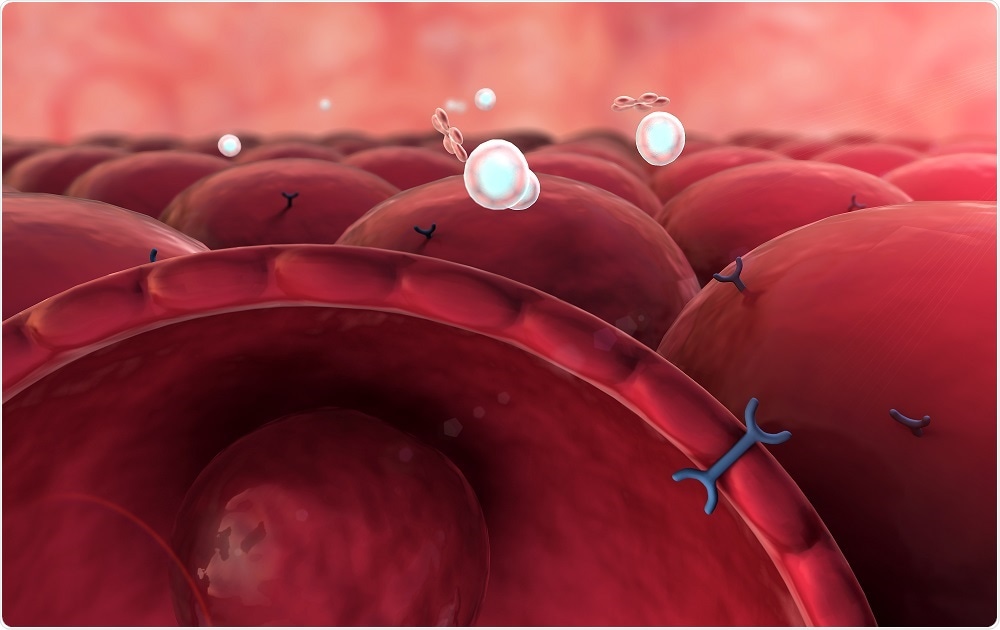An interview with Dr. Cedric Garland, DrPH, conducted by Kate Anderton, BSc
Why is vitamin D important for the human body?
Vitamin D is essential to the human body for a number of reasons. The first is that vitamin D is needed to absorb calcium, and also move calcium from the blood into the bone. This is necessary to prevent rickets.
 Image Credit: Syda Productions / Shutterstock
Image Credit: Syda Productions / Shutterstock
Vitamin D is produced only in response to exposure to sunlight. Inadequate sunlight was discovered to be the main cause of rickets in 1832 in Poland. This was before the vitamin D compound was discovered.
In 1890, Theodore Palm published a paper showing that rickets was due to a deficiency of sunlight. Sunlight was later found to be the source of Vitamin D, solving the mystery of the high incidence of rickets in the dark, narrow streets of winter in Europe’s major cities, especially those with air pollution such as London and Warsaw. A few decades later, vitamin D was discovered by Elmer McCollum of The Johns Hopkins University in Baltimore.
Vitamin D is also important for the prevention and alleviation of chronic diseases in addition to rickets. The first example of this was the discovery that Vitamin D prevents cancer by our group in 1980. Since then, there have been 8,550 papers published on vitamin D and cancer.
Much of this progress was also due to William B, Grant, Ph.D., of the Sunlight and Nutrition Research Center in California). We are now confident that vitamin D can prevent certain forms of cancer. Similar epidemiological research has implicated vitamin D deficiency in multiple sclerosis.
The most recent discovery in the history of Vitamin D is that it also prevents diabetes. This discovery came to light over the past two decades, based on papers that my team (Dr. Frank Garland, who is now deceased, and Dr. Edward D. Gorham of the University of California San Diego) published with close colleagues including Dr. Elizabeth Barrett-Connor, Dr. Sharif Mohr, and Dr. Raphael Cuomo (of UC San Diego), and Sue Park (of Seoul National University) during the past 10 years. These studies confirmed that vitamin D3 really can prevent Type 2 diabetes.
Our work was preceded by that of Elina Hypponnen and colleagues of London (2001) and others who found that vitamin D adequacy throughout childhood and early adulthood is able prevent nearly 100% of Type 1 diabetes. It has become clear that vitamin D3 has an extremely powerful effect.
On a cellular level, why is vitamin D important?
Vitamin D improves the adherence of one cell to another, allowing them to communicate more effectively. This allows diverse tissues that are analogous to cooperative colonies of cells that make up the body to work in harmony, rather than as individual cells that compete for limited resources by rapid growth, and, ultimately aggression.
When a person is lacking vitamin D, the integrity of the junctions between their cells is compromised. Communication is impaired and the cells no longer inhibit the growth of neighboring cells. Lacking inhibition by neighboring cells, uncontrolled proliferation begins in one or more tissues.
Natural selection leads to the emergence of the clone of fast-reproducing, aggressive cells that make up cancer. The process is predictably Darwinian, sadly unleashed by vitamin D3 deficiency.
 Image Credit: Kavun Halyna / Shutterstock
Image Credit: Kavun Halyna / Shutterstock
How much vitamin D is currently recommended per day?
In the US, the principal authority on vitamins is the National Academy of Medicine. They had a meeting in 2010, during which they attempted to set a daily recommended amount of intake of vitamin D. The meeting participants included a group of 16 or so specialists, including myself. The convenors did two things, one of which was not very useful, but the other of which was extremely useful.
The less useful decision was to specify a recommended daily allowance of 600 IU vitamin D/day in people younger than 70, and 800 IU/day in people over 71. This was a huge increase compared to their previous recommendations of 200 IU and 400 IU per day, respectively, but it was dreadfully low with respect to the existing research on the extraskeletal benefits of vitamin D, that they did not use in selecting the recommended daily allowance.
However, what they did do, which was a wonderful thing for the field, was to recommend a Tolerable Upper Level Intake of 4,000 IU/day for every person aged 9 and older. That means it is safe for men, women, and children age 9 and older to take 4,000 international units a day of vitamin D3. They approved this at a time when the average intake of vitamin D in the US was approximately 200 IU per day.
Stating that it was safe for people to take 20 times the mean population intake made it possible to do clinical trials without interference or worry that the dosage would be too high. Physicians were also able to confidently start recommending up to 4,000 IU/day to their patients.
How do humans obtain vitamin D? How can humans boost their vitamin D levels if they are deficient?
In much of the world, at least in the equatorial part of the world, one could theoretically make enough vitamin D naturally. The problem is that for most of our evolution, we didn't have anything covering the skin, except maybe some hair, which we lost for the most part, and replaced with clothing.
The organ that makes Vitamin D3 is the skin, and the average person who has only their face and hands exposed blocks 92% of the biosynthesis of Vitamin D3, because they’re only exposing 8% of their skin in total.
So, even if you lived in an extremely sunny place, because we wear clothing, you won’t be able to make enough vitamin D to experience the benefits it offers. This means the solution for most people is vitamin D3 supplementation.
If the person goes to a doctor, they'll be given a large dose every day until their vitamin D levels rise to at least 60ng/ml 25-Hydroxy Vitamin D. The dose prescribed for these people is usually not in excess of 10,000 IU, and is lowered to 4,000 IU when the patient’s blood levels of vitamin D have risen sufficiently.
Please describe your recent research on diabetes.
A decade ago, our team analyzed the diabetes registries of 52 countries from around the world, and found that the development of diabetes was almost fully correlated with exposure to UV radiation, or sunlight. The more sunlight, the less Type 1 diabetes.
The incidence of Type 1 diabetes tends to be low in most populations living near the equator, but is extremely high at latitudes of 45 degrees and higher in both Northern and Southern hemispheres. It has a signature; it's called a cosine law.
We call the curve of the association between latitude or sunlight intensity a “smiley” when we plot it as a graph with points displayed by latitude and incidence rates of a disease. We display southern latitudes on the left side of the horizontal axis, equator in the middle of this axis, and northern latitudes on the right side of it.
The vertical axis is the age-standardized incidence rate of the diseases. When it looks like a smile, it strongly suggests that the disease is due to Vitamin D deficiency. This is because incidence rates of many diseases very closely aligns with the intensity of sunlight at the latitude of residence in both the Northern and Southern Hemispheres.
Now, it is absolutely established beyond a shadow of a doubt epidemiologically that virtually all Type 1 diabetes is due to Vitamin D deficiency, and it's tragic and irresponsible that we're not preventing it.
It wasn't until more recently that investigators throughout the world began to wonder whether Type 2 diabetes, which we thought could be explained so easily by the over consumption of food, might be related to inadequacy of sunlight and vitamin D3.
In our study, we collected the blood of 2000 people and did a fasting plasma glucose test and glucose tolerance test. Using the UN criteria for diabetes, we were able to exclude any patients with diabetes, leaving us with 900 non-diabetics.
We followed these patients for 12 years, and measured the vitamin D levels in their blood. We were excited and happy to find that people who had the highest amount of the predominant vitamin D metabolite in their blood (60 ng/ml) were five times less likely to develop Type 2 diabetes over that 12-year period than those who had the lowest (20 ng/ml or less).
Many scientists expected that maybe vitamin D might do something favorable with regard to Type 2 diabetes, and almost all scientists from the world of epidemiology agreed it was beneficial, but possibly no one but our team thought it was going to be able to prevent 80%. Now we are essentially sure that it can.
Some scientists wondered why we observed such a strong effect of vitamin D compared to previous studies of Type 2 diabetes. It's not terribly complicated to explain that.
All the participants lived in Rancho Bernado, California, a very sunny place where people love to get outdoors; they enjoy swim in numerous swimming pools, and often wear minimal clothing while doing many activities in the abundant sunlight. As a result, they have the highest levels of vitamin D in their blood of any cohort ever studied – almost twice the amount observed in previous studies.
We're very confident in our findings, and truly believe that we could prevent 80% of Type 2 diabetes if we could raise the level of 25-hydroxyvitamin D to 50 nanograms per milliliter of blood. Only about 2 percent of the US and European populations are at that level now.
What do you think needs to be done to improve the average daily intake of vitamin D?
We need to convince doctors and allied health care professionals that the current standard of 20 ng/ml of 25-hydroxyvitamin D just isn’t enough. It’s enough to prevent bone disease, but it won’t touch diabetes unless it’s 50ng/ml.
For most of the world, people can’t get this amount by going outdoors. They have to take a supplement, and it generally has to be approximately 4,000 IU/day from age 9 and onward. The tolerable upper level dose of vitamin D3 of the U.S. Institute of Medicijne starts at 1000 IU/day at birth and rises slowly with age to 4,000 IU/day at age 9.
Incidentally, vitamin D2 (ergocalciferol) is ineffective for prevention of diabetes and cancer, and should be avoided. Bolus doses, such as monthly and possibly weekly large doses are also ineffective, since the native vitamin D3 has a half life of less than a day and could at least possibly contribute to the preventive process observed in epidemiologic studies of vitamin D.
We know of a population in Thailand that gets up to 40ng/ml without supplementation, but they don't have much air conditioning, and they're outdoors a whole lot. People in Africa who are out on the plains will also get up to that level if they wear minimal clothing. But otherwise, the way we live our lives in most of the world, we need to supplement with Vitamin D3 every single day.
Why do you think vitamin D levels were associated with an increased risk of pre-diabetes?
We came up with a model, called the DIAB model, which stands for the order in which diabetes develops: vitamin D, insulin, autoimmunity and beta cells.
 Image Credit: URGREEN3S / Shutterstock
Image Credit: URGREEN3S / Shutterstock
The way diabetes starts out is vitamin D deficiency, which is common in much of world’s population. There is an extremely delicate microscopic membrane in the pancreas that separates the endocrine cells that produce insulin (beta cells) from the exocrine cells that secrete pancreatic enzymes.
The beta cells that produce insulin exist within a compartment of fluid inside the Islets of Langerhans, and are protected by this membrane that requires electron microscopy and metallic stains to visualize .
When a person becomes deficient in vitamin D, this delicate membrane becomes compromised, and infectious agents that occur in the GI tract can access the Islets of Langerhans, and infect the delicate insulin-producing beta cells. These cells are generally post-mitotic, so cannot readily regenerate their population following cell death.
In response to infection, the beta cell displays an antigen on its surface which is detected by the immune system. The beta cells also release cytokines, causing migration of killer lymphocytes across the membrane. These immune cells target and kill infected beta cells, and since beta cells are the sole source of insulin, reduce the amount of insulin produced by the pancreas.
Over time, as infectious agents continue to penetrate the compromised membrane and infect more beta cells, the population of beta cells diminishes to zero, and the patient develops diabetes.
The material that holds the cells together is E-CaDherin. E stands for epithelial, Ca for calcium, and D for vitamin D. Herin is derived from adhaerere, a Latin word for sticking. E-cadherin acts like a glue, holding cells together and keeping the delicate protective membrane intact.
We're lucky that science has discovered this model. Unlike type 2 diabetes, most children who get Type 1 diabetes are not typically overweight, nor do they eat an excess of sweets. Often, it’s a pale, thin child who gets Type 1 diabetes.
Now, we know it’s because the Type 1 diabetes victims are vitamin D deficient. Vitamin D3 supplementation can enhance intercellular adherence of the membrane-producing cells, helping to prevent diabetes.
What are the next steps for your research?
For now, we’re going to continue to do research into it, and try to convince more people that supplementation is a realistic measure to prevent diabetes.
Currently, charities and governments are putting most of their limited resources into developing a treatment for diabetes, mainly by use of stem cell implants. They do not seem to be terribly interested in preventing it. But if we don’t start working to prevent diabetes, eventually possibly a quarter of the population may need an expensive and risky stem cell implant that can be rejected.
I would like to see vitamin D become part of the standard of care for all patients. Doctors should measure the serum or plasma Vitamin D levels (specifically 25-hydroxyvitamin D3) of everyone, every year, and recommend vitamin D3 supplements to their patients until they reach 50 nanograms per milliliter.
According to our research, that should prevent 80% cases. Then, we can as a society focus further on stem-cell transplants and other innovations for treating the remaining 20%.
Where can readers find more information?
About Dr. Cedric Garland, DrPH
 Dr. Garland is an adjunct professor in the Division of Epidemiology, Department of Family Medicine and Public Health at University of California San Diego. He is also a Fellow of the American College of Epidemiology. Dr. Garland is the author or coauthor of 150 abstracts, book chapters and research publications, mainly about breast and colon cancer and melanoma.
Dr. Garland is an adjunct professor in the Division of Epidemiology, Department of Family Medicine and Public Health at University of California San Diego. He is also a Fellow of the American College of Epidemiology. Dr. Garland is the author or coauthor of 150 abstracts, book chapters and research publications, mainly about breast and colon cancer and melanoma.
With his collaborators, he has developed a novel cancer theory, the Devolution hypothesis, based mainly on their research on the role of vitamin D in reducing the risk of cancer and improving healthy survival of cancer patients.